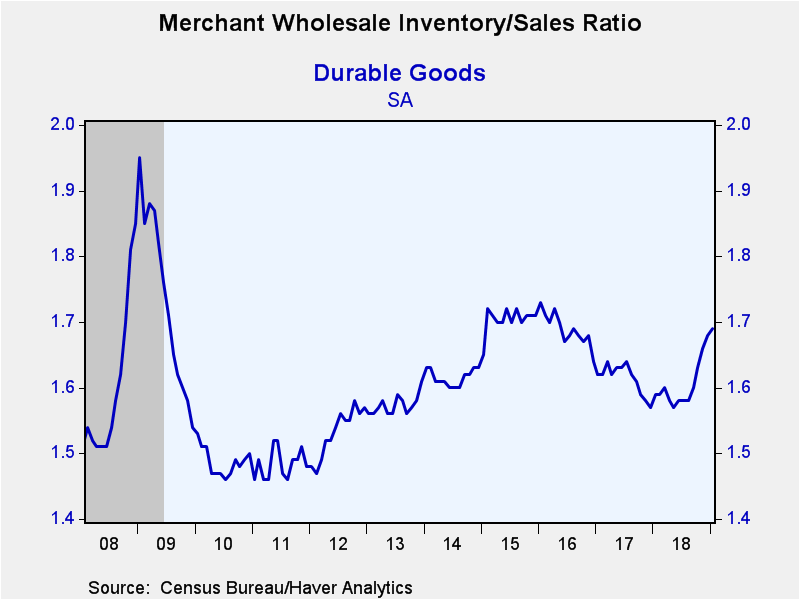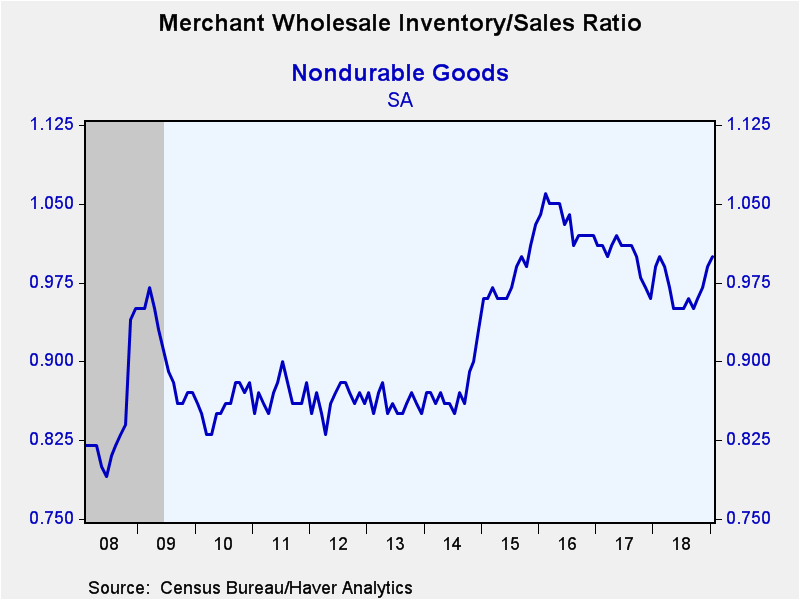 Global| Mar 22 2019
Global| Mar 22 2019Wholesale Inventories and Sales Rise
Summary
Wholesale inventories increased 1.2% month-on-month (7.7% year-over-year) during January following a 1.1% gain (this report was delayed as a result of the government shutdown). The Informa Global Markets Survey expected a 0.2% rise. [...]
Wholesale inventories increased 1.2% month-on-month (7.7% year-over-year) during January following a 1.1% gain (this report was delayed as a result of the government shutdown). The Informa Global Markets Survey expected a 0.2% rise. Wholesale inventory swings can have a meaningful impact on GDP. In the second and third quarters of 2018 changes in inventories subtracted 1.2 percentage points and then added 2.3 ppt respectively. In Q4, inventories provided just a 0.1 percentage point boost.
Durable goods inventories increased 0.9% (11.7% y/y) in January after a 1.7% gain. Machinery inventories, the largest sector, grew 1.0% (13.7% y/y), while vehicles, the second largest, advanced 1.4% (9.5% y/y). Electrical equipment was up 3.0% (9.8% y/y). Inventories of nondurable goods gained 1.6% (1.8% y/y) after edging up 0.1% in December. Drug inventories, which make up a quarter of nondurable inventories, rose 1.3% (-2.7% y/y). Groceries, the second largest category, ticked up 0.2% (1.8% y/y). Miscellaneous nondurables increased 1.3% (7.6% y/y).
Wholesale sales grew 0.5% during January (2.7% y/y) after a 0.9% drop. The Action Economics Forecast Survey looked for a 0.4% gain.
Durable goods sales were unchanged (4.7% y/y) after a 0.6% increase. Electrical equipment, the largest sector, fell 2.1% (+2.7% y/y). Professional and commercial equipment, which includes computers, declined 0.5% (+0.6% y/y). These decreases were somewhat offset by a 2.5% jump in wholesale vehicle sales (3.3% y/y). Nondurable product sales rose 0.9% (0.9% y/y) after dropping 2.3%. Petroleum products increased 1.1% after 10.9% drop in December (-6.2% y/y). Oil prices fell at end of last year, but have slowly increased since. Drug sales, which are now the largest category as a result of the decline in petroleum prices, grew 0.6% (4.9% y/y) while groceries gained 1.0% (3.8% y/y).
The inventory-to-sales (I/S) ratio at the wholesale level rose to 1.34, the fifth consecutive gain. The I/S ratio for durable goods increased to 1.69, the highest level in two-and-a-half years. The machinery ratio grew to 2.66 while motor vehicles declined to 1.70. The I/S ratio for nondurable goods increased to 1.0. The petroleum industry I/S ratio picked up to 0.41 after reaching a four-year low of 0.35 in November. The drug industry I/S rose to 1.05 after hitting a five-and-a-half-year low of 1.04 in December.
The wholesale trade figures and oil prices are available in Haver's USECON database. The expectations figure for inventories is contained in the MMSAMER database. Expectations for sales are in the AS1REPNA database.
Wholesele inventories increased 0.3% month-on-month (6.5% year-over-year) during NovemberPREVIOUS DATA: Wholesale inventories Series 1: diff%(NWIH@USECON) NWIH@USECON [Merchant Wholesalers: Inventories: Total (EOP, SA, Mil.$)] 2018 - Oct 0.860 2018 - Nov 0.367 2018 - Dec 1.089
Wholesale sales Series 1: diff%(NWSH@USECON) NWSH@USECON [Merchant Wholesalers: Sales: Total (SA, Mil.$)] 2018 - Oct -0.562 2018 - Nov -1.230 2018 - Dec -0.951
The wholesale trade figures are available in Haver's USECON database. The expectations for sales are in the AS1REPNA database.
| Wholesale Sector - NAICS Classification (%) | Jan | Dec | Nov | Y/Y | 2018 | 2017 | 2016 |
|---|---|---|---|---|---|---|---|
| Inventories | 1.2 | 1.1 | 0.4 | 7.7 | 7.3 | 3.4 | 2.2 |
| Sales | 0.5 | -0.9 | -1.2 | 2.7 | 7.2 | 7.4 | -1.3 |
| I/S Ratio | 1.3 | 1.3 | 1.3 | 1.3 (Jan '18) | 1.3 | 1.3 | 1.3 |
Gerald D. Cohen
AuthorMore in Author Profile »Gerald Cohen provides strategic vision and leadership of the translational economic research and policy initiatives at the Kenan Institute of Private Enterprise.
He has worked in both the public and private sectors focusing on the intersection between financial markets and economic fundamentals. He was a Senior Economist at Haver Analytics from January 2019 to February 2021. During the Obama Administration Gerald was Deputy Assistant Secretary for Macroeconomic Analysis at the U.S. Department of Treasury where he helped formulate and evaluate the impact of policy proposals on the U.S. economy. Prior to Treasury, he co-managed a global macro fund at Ziff Brothers Investments.
Gerald holds a bachelor’s of science from the Massachusetts Institute of Technology and a Ph.D. in Economics from Harvard University and is a contributing author to 30-Second Money as well as a co-author of Political Cycles and the Macroeconomy.









